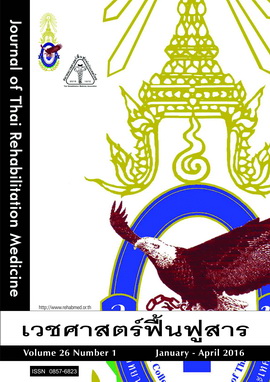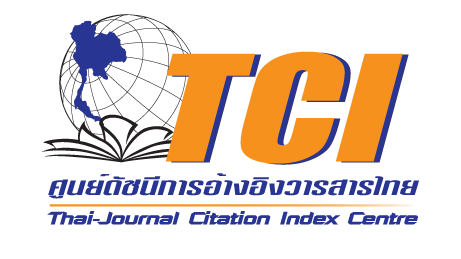ความสัมพันธ์ระความสัมพันธ์ระหว่างการประเมินการทำงานของแขนด้วย เครื่อง SensibleTAB กับการประเมินด้วย Fugl-Meyer Scale ในผู้ป่วยโรคหลอดเลือดสมอง: การศึกษาเบื้องต้นหว่างการประเมินการทำงานของแขนด้วย เครื่อง SensibleTAB กับการประเมินด้วย Fugl-Meyer Scale ในผู้ป่วยโรคหลอดเลือดสมอง: การศึกษาเบื้องต้น
ความสัมพันธ์ระหว่างการประเมินการทำงานของแขนด้วย เครื่อง SensibleTAB กับการประเมินด้วย Fugl-Meyer Scale ในผู้ป่วยโรคหลอดเลือดสมอง: การศึกษาเบื้องต้น
Keywords:
hemiparesis, stroke, arm function assessment, roboticsAbstract
ABSTRACT
Objectives: To study a correlation between hemiplegic arm function assessment with Fugl-Meyer and SensibleTAB robotic device.
Study design: correlational research
Setting: Department of Rehabilitation Medicine, Samrong General Hospital
Subjects: Patients with hemiplegic arm paresis due to stroke, who came to the hospital for a follow-up visit or rehabilitation during 1 January until 31 August 2013. Patients who could understand and co-operate with the testing procedure and gave informed consent were included in the study.
Methods: Each patient underwent the SensibleTAB and the Fugl-Meyer arm funciton assessments on the same day. One researcher scored the Fugl-Meyer assessment in all patients.
Results: We assessed 10 patients: 4 with cerebral infarction and 6 with cerebral hemorrhage. The scores of the SensibleTAB and the Fugl-Meyer assessments are statistically correlated (R2 = 0.755, p<0.001)
Conclusion: The scores of SensibleTAB in stroke patients with hemiparesis are statistically correlated with Fugl-Meyer scale score.
References
Stewart JC, Gordon J, Winstein CJ. Control of reach extent with the paretic and nonparetic arms after unilateral sensorimotor stroke: kinematic differences based on side of brain damage. Exp Brain Res 2014; 232(7): 2407-19.
Lin JH, Hsu MJ, Sheu CF, Wu TS, Lin RT, Chen CH, et al. Psychometric comparisons of 4 measures for assessing upper-extremity function in people with stroke. Phys Ther 2009; 89(8): 840-50.
Fugl-Meyer AR, JääsköL, Leyman I, Olsson S, Steglind S. The post-stroke hemiplegic patient. 1. a method for evaluation of physical performance. Scand J Rehabil Med 1975; 7(1): 13-31.
Gladstone DJ, Danells CJ, Black SE. The fugl-meyer assessment of motor recovery after stroke: a critical review of its measurement properties. Neurorehabil Neural Repair 2002; 16(3): 232-40.
Metrot J, Froger J, Hauret I, Mottet D, van Dokkum L, Laffont I. Motor recovery of the ipsilesional upper limb in subacute stroke. Arch Phys Med Rehabil 2013; 94(11): 2283-90.
Krebs HI, Krams M, Agrafiotis DK, DiBernardo A, Chavez JC, Littman GS, et al. Robotic measurement of arm movements after stroke establishes biomarkers of motor recovery. Stroke 2014; 45(1): 200-4.
Simo L, Botzer L, Ghez C, Scheidt RA. A robotic test of proprioception within the hemiparetic arm post-stroke. J Neuroeng Rehabil 2014; 11: 77.






